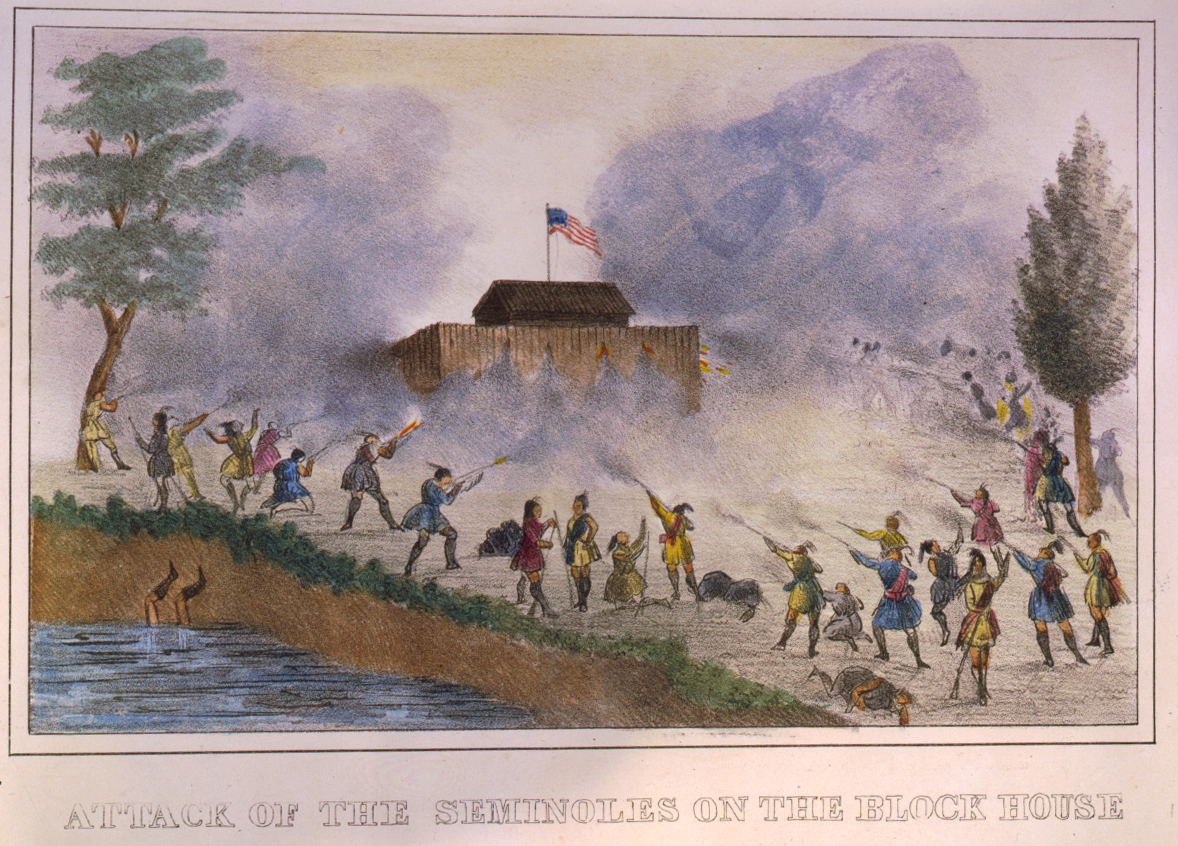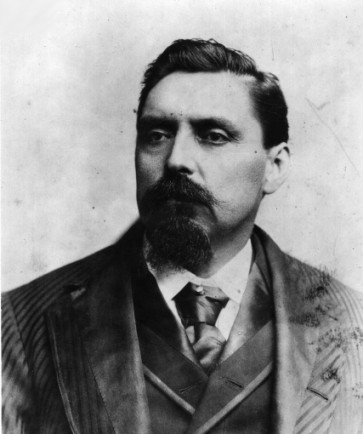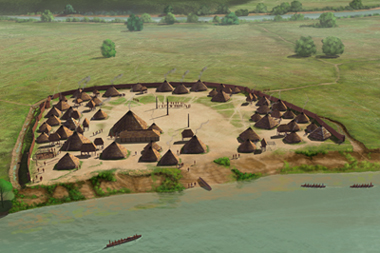|
Mikasuki
The Miccosukee Tribe of Indians of Florida is a federally recognized Native American tribe in the U.S. state of Florida. They were part of the Seminole nation until the mid-20th century, when they organized as an independent tribe, receiving federal recognition in 1962. The Miccosukee speak the Mikasuki language, which is mutually intelligible with the Hitchiti language, is considered its dialect, and is also spoken by many Florida Seminole. Historically, the Miccosukee trace their origins to the Lower Chiaha, one of the tribes of the Creek Confederacy in present-day Georgia. Under pressure from European encroachment in their territory, they migrated to northern Florida in the early 18th century, where they became part of the developing Seminole nation.Pritzker, p. 390. By the late 18th century, the British recorded the name Miccosukee or Mikasuki as designating a Hitchiti-speaking group centered on the village of Miccosukee in the Florida Panhandle. Like other Seminole groups, ... [...More Info...] [...Related Items...] OR: [Wikipedia] [Google] [Baidu] |
Hitchiti Language
The Mikasuki, Hitchiti-Mikasuki, or Hitchiti language is a language or a pair of dialects or closely related languages that belong to the Muskogean languages family. Mikasuki was spoken by around 290 people in southern Florida. Along with the Cow Creek Seminole dialect of Muscogee, it is also known as Seminole. It is spoken by members of the Miccosukee tribe and of the Seminole Tribe of Florida. The extinct Hitchiti was a mutually intelligible dialect. Hitchiti was one of the many Muskogee languages spoken by tribes of the loose Muscogee Confederacy, and is considered by many scholars to be the ancestor of the Mikasuki language. It was spoken in Georgia and eastern Alabama in the early historic period, with speakers moving into Florida during the 18th and 19th centturies. Hitchiti was the language of tribal towns such as the Hitchiti, Chiaha, Oconee, Okmulgee, Sawokli, and Apalachicola. Based on the number of place names that have been derived from the language, scholars belie ... [...More Info...] [...Related Items...] OR: [Wikipedia] [Google] [Baidu] |
Mikasuki Language
The Mikasuki, Hitchiti-Mikasuki, or Hitchiti language is a language or a pair of dialects or closely related languages that belong to the Muskogean languages family. Mikasuki was spoken by around 290 people in southern Florida. Along with the Cow Creek Seminole dialect of Muscogee, it is also known as Seminole. It is spoken by members of the Miccosukee tribe and of the Seminole Tribe of Florida. The extinct Hitchiti was a mutually intelligible dialect. Hitchiti was one of the many Muskogee languages spoken by tribes of the loose Muscogee Confederacy, and is considered by many scholars to be the ancestor of the Mikasuki language. It was spoken in Georgia and eastern Alabama in the early historic period, with speakers moving into Florida during the 18th and 19th centturies. Hitchiti was the language of tribal towns such as the Hitchiti, Chiaha, Oconee, Okmulgee, Sawokli, and Apalachicola. Based on the number of place names that have been derived from the language, scholars belie ... [...More Info...] [...Related Items...] OR: [Wikipedia] [Google] [Baidu] |
Seminole
The Seminole are a Native American people who developed in Florida in the 18th century. Today, they live in Oklahoma and Florida, and comprise three federally recognized tribes: the Seminole Nation of Oklahoma, the Seminole Tribe of Florida, and the Miccosukee Tribe of Indians of Florida, as well as independent groups. The Seminole people emerged in a process of ethnogenesis from various Native American groups who settled in Spanish Florida beginning in the early 1700s, most significantly northern Muscogee Creeks from what is now Georgia and Alabama. The word "Seminole" is derived from the Muscogee word ''simanó-li''. This may have been adapted from the Spanish word ''cimarrón'', meaning "runaway" or "wild one". Seminole culture is largely derived from that of the Creek; the most important ceremony is the Green Corn Dance; other notable traditions include use of the black drink and ritual tobacco. As the Seminole adapted to Florida environs, they developed local traditions ... [...More Info...] [...Related Items...] OR: [Wikipedia] [Google] [Baidu] |
Seminole Wars
The Seminole Wars (also known as the Florida Wars) were three related military conflicts in Geography of Florida, Florida between the United States and the Seminole, citizens of a Native Americans in the United States, Native American nation which formed in the region during the early 1700s. Hostilities commenced about 1816 and continued through 1858, with two periods of uneasy truce between active conflict. The Seminole Wars were the longest and most expensive, in both human and financial cost to the United States, of the American Indian Wars. Overview First Seminole War The First Seminole War (1817-1818)-"Beginning in the 1730's, the Spaniards had given refuge to runaway slaves from the Carolinas, but as late as 1774 Fugitive slaves in the United States, Negroes [did] not appear to have been living among the Florida Indians." After that latter date more runaway slaves began arriving from American plantations, especially congregating around "Negro Fort on the Apalachicola Riv ... [...More Info...] [...Related Items...] OR: [Wikipedia] [Google] [Baidu] |
Second Seminole War
The Second Seminole War, also known as the Florida War, was a conflict from 1835 to 1842 in Florida between the United States and groups collectively known as Seminoles, consisting of Native Americans in the United States, Native Americans and Black Indians in the United States, Black Indians. It was part of a series of conflicts called the Seminole Wars. The Second Seminole War, often referred to as ''the'' Seminole War, is regarded as "the longest and most costly of the American Indian Wars, Indian conflicts of the United States". After the Treaty of Payne's Landing in 1832 that called for the Seminole's removal from Florida, tensions rose until open hostilities started with Dade battle. For the next four years, the Seminole and the U.S. forces engaged in small engagements and by 1842 only a few hundred native peoples remained in Florida. The war was declared over on August 14, 1842. Background Bands from various tribes in the southeastern United States had moved into the uno ... [...More Info...] [...Related Items...] OR: [Wikipedia] [Google] [Baidu] |
Miccosukee Tribe
The Miccosukee Tribe of Indians of Florida is a federally recognized Native American tribe in the U.S. state of Florida. They were part of the Seminole nation until the mid-20th century, when they organized as an independent tribe, receiving federal recognition in 1962. The Miccosukee speak the Mikasuki language, which is mutually intelligible with the Hitchiti language, is considered its dialect, and is also spoken by many Florida Seminole. Historically, the Miccosukee trace their origins to the Lower Chiaha, one of the tribes of the Creek Confederacy in present-day Georgia. Under pressure from European encroachment in their territory, they migrated to northern Florida in the early 18th century, where they became part of the developing Seminole nation.Pritzker, p. 390. By the late 18th century, the British recorded the name Miccosukee or Mikasuki as designating a Hitchiti-speaking group centered on the village of Miccosukee in the Florida Panhandle. Like other Seminole groups, ... [...More Info...] [...Related Items...] OR: [Wikipedia] [Google] [Baidu] |
Seminole Tribe Of Florida
The Seminole Tribe of Florida is a federally recognized Seminole tribe based in the U.S. state of Florida. Together with the Seminole Nation of Oklahoma and the Miccosukee Tribe of Indians of Florida, it is one of three federally recognized Seminole entities. It received that status in 1957; today it has six Indian reservations in Florida. In 1975, the Tribe established tax-free smoke shops and a high-stakes bingo operation that became one of the first tribal gaming endeavors in the United States. These ventures, particularly the gaming operation, have generated significant revenues for education, welfare and economic development. A 2005 tribal audit said it took in $1.1 billion in revenues that year.Sally Kestin, "FEMA paid tribe's hotel tab" ''Sun ... [...More Info...] [...Related Items...] OR: [Wikipedia] [Google] [Baidu] |
Seminole Nation Of Oklahoma
The Seminole Nation of Oklahoma is a List of federally recognized tribes, federally recognized Native Americans in the United States, Native American tribe based in the U.S. state of Oklahoma. It is the largest of the three federally recognized Seminole governments, which include the Seminole Tribe of Florida and the Miccosukee Tribe of Indians of Florida. Its members are descendants of the 3,000 Seminoles who were Indian removal, forcibly removed from Florida to Indian Territory, along with 800 Black Seminoles, after the Second Seminole War. The Seminole Nation of Oklahoma is headquartered in Wewoka, Oklahoma, Wewoka within Seminole County, Oklahoma. Of 18,800 enrolled tribal members, 13,533 live in Oklahoma. The tribe began to revive its government in 1936 under the Indian Reorganization Act. While its reservation was originally larger, today the tribal jurisdictional area covers Seminole County, Oklahoma, within which it has a variety of properties. The few hundred Seminoles re ... [...More Info...] [...Related Items...] OR: [Wikipedia] [Google] [Baidu] |
Miccosukee, Florida
Miccosukee is a small unincorporated community in northeastern Leon County, Florida, United States. It is located at the junction of County Road 59 (Veterans Memorial Drive) and County Road 151 (Moccasin Gap Road). Miccosukee was a major center of the Miccosukee tribe, one of the tribes of the developing Seminole nation, during the 18th century. Geography Miccosukee, like other unincorporated areas in northern Leon County, is an area of rolling hills dotted with ponds and lakes. The large, swampy Lake Miccosukee borders the eastern edge of the community. History The town of Miccosukee or Mikasuki was settled by members of the Miccosukee tribe, a group of Creek origin who had settled in Florida and become part of the developing Seminole nation. The Miccosukee often fought armed battles with white settlers. It was mapped by the British in 1778 and originally called Mikasuki with 60 homes, 28 families, and a town square. Some 70 gunmen protected the town. It was the capital of th ... [...More Info...] [...Related Items...] OR: [Wikipedia] [Google] [Baidu] |
Creek Confederacy
The Muscogee, also known as the Mvskoke, Muscogee Creek, and the Muscogee Creek Confederacy ( in the Muscogee language), are a group of related indigenous (Native American) peoples of the Southeastern WoodlandsTranscribed documents Sequoyah Research Center and the American Native Press Archives in the . Their original homelands are in what now comprises southern , much of , western |
Muscogee (Creek)
The Muscogee, also known as the Mvskoke, Muscogee Creek, and the Muscogee Creek Confederacy ( in the Muscogee language), are a group of related indigenous (Native American) peoples of the Southeastern WoodlandsTranscribed documents Sequoyah Research Center and the American Native Press Archives in the . Their original homelands are in what now comprises southern , much of , western |
Creek People
The Muscogee, also known as the Mvskoke, Muscogee Creek, and the Muscogee Creek Confederacy ( in the Muscogee language), are a group of related indigenous (Native American) peoples of the Southeastern WoodlandsTranscribed documents Sequoyah Research Center and the American Native Press Archives in the . Their original homelands are in what now comprises southern , much of , western |


.jpg)



